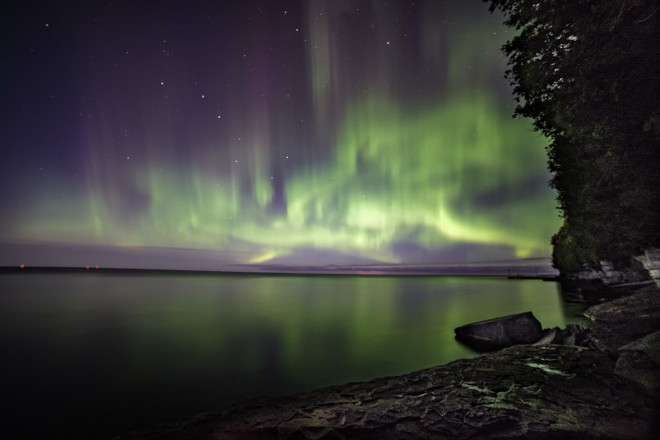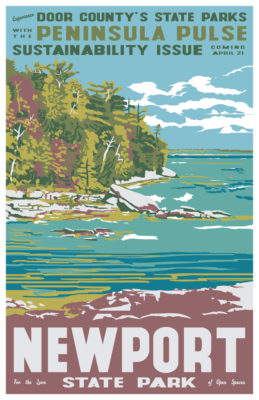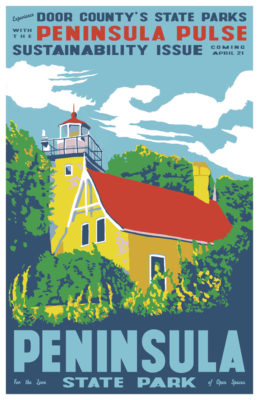In Search of the Northern Lights
- Share
- Tweet
- Pin
- Share

More than a handful of times during the past year, I have come into work, opened my email, and been amazed by a number of submitted photos of “last night’s aurora borealis” – vivid images of dark skies covered in sheets of green, navy and magenta, a result of collisions between charged particles from the sun and Earth’s magnetic field.
It has been almost two decades since the single time I witnessed the northern lights. My mom had woken me up in the wee hours of the morning and when I shuffled from under the covers to the north-facing window in her bedroom and saw the stretch of glowing green and purple in the distant sky, I knew instantly that such an occasion would always be worth getting up for. What I didn’t know was how people knew when to look for it.
Door County’s dark skies and low levels of light pollution, especially in the northernmost part, offer great opportunities to see the aurora borealis. In my time here, however, I have yet to witness it. Last week, when a few headlines ran past my radar that residents of Northeast Wisconsin might catch a glimpse of the northern lights the first week of November, I decided to pursue the information I would need to finally witness this phenomenon in Door County.
Naturally, I turned to Michelle Hefty, superintendent of Newport State Park, which is currently pursuing a dark-sky designation from the International Dark-Sky Association. The designation is granted to a land “possessing an exceptional or distinguished quality of starry nights and a nocturnal environment.” Translation? Excellent visibility of cosmic events.
“There is a lot of interest in seeing [the northern lights] and I think mainly because a lot of people are coming out of the cities,” Hefty added. “With light pollution, you can’t see them … there really is no external lighting in the sky from villages north of us so if we do see those colors and those hues and that, you pretty much know it’s the northern lights.”
As its name implies, the best place to see the aurora borealis is somewhere with good visibility of the north. Since Newport State Park rests on the east side of the peninsula, Hefty guides visitors to Europe Bay Road and toward the outer edge of the park. The phenomenon can happen any time during the year, since “it comes on the storms on the sun,” Hefty said, meaning the only way our weather system impacts visibility is if our sky is overcast.
My mother saw the northern lights because, as a parent of 10 kids, her mornings tended to start before 5 am. Her windows faced north and we were fortunate to be located south of Shawano and the start of the great North woods, so our view was not spoiled by light pollution. It was by sheer luck, then, that she saw them – after all, we didn’t have a computer at the time and smartphones didn’t exist.
Today, things are much different. So I wasn’t surprised to hear the answer when I asked Hefty how people know when to look for the aurora borealis.
“There’s an app for that,” she quipped. “And a couple of Facebook sites where people can get notifications of the potential for northern lights.”
She is referring to the free Aurora Notifier and the $2.99 Aurora Alert, both for Android, as well as the Aurora Forecast for iPhone. Hefty also recommends two Facebook pages: “Great Lakes Aurora Hunters,” and “Aurora Alerts by Soft Serve News.”
Perhaps most reliable, Hefty said, is the website of the National Oceanic and Atmospheric Administration (NOAA), swpc.noaa.gov. On the home page, visitors may click on ‘The Aurora’ forecast, which provides a map of the Earth from the North Pole’s perspective, along with a percentage meter that predicts the probability of a visible aurora.
While smartphones are the way to find out when the northern lights will probably occur, they are not the way to go when it comes to capturing them on camera. Ask Gills Rock summer resident and photographer Denny Moutray, whose online gallery is filled with amazing photos of the aurora borealis.
Moutray offers his best tips for immortalizing the scene.
“People think they can take pictures, even with a point-and-shoot camera but it’s impossible,” Moutray added. “There has only been twice this past year that I have actually sat there with the naked eye and could watch them really well. Most of the time, you need the camera to pick that up. They’re hard to see and you’ve got to know what to look for … I look above the horizon and if I start to see what looks like streaks in the sky, like searchlights, that’s when I know they’re starting to get active.
“I set up the tripod, set up the camera, get my manual settings, and then I set [the exposure] for 30 seconds,” he added. “During that 30 seconds, the sensor of the camera is picking up whatever is in front of it.”
Even with a good camera and fast lens in hand, along with good positioning to the north, the biggest lesson in capturing the northern lights is patience.
“I’ve been out there some nights three or four hours just waiting before I’ve seen something happen,” Moutray said. “It’s not for the faint of heart … but all you need to do is see them once really well and you’ll say it’s worth it.”


